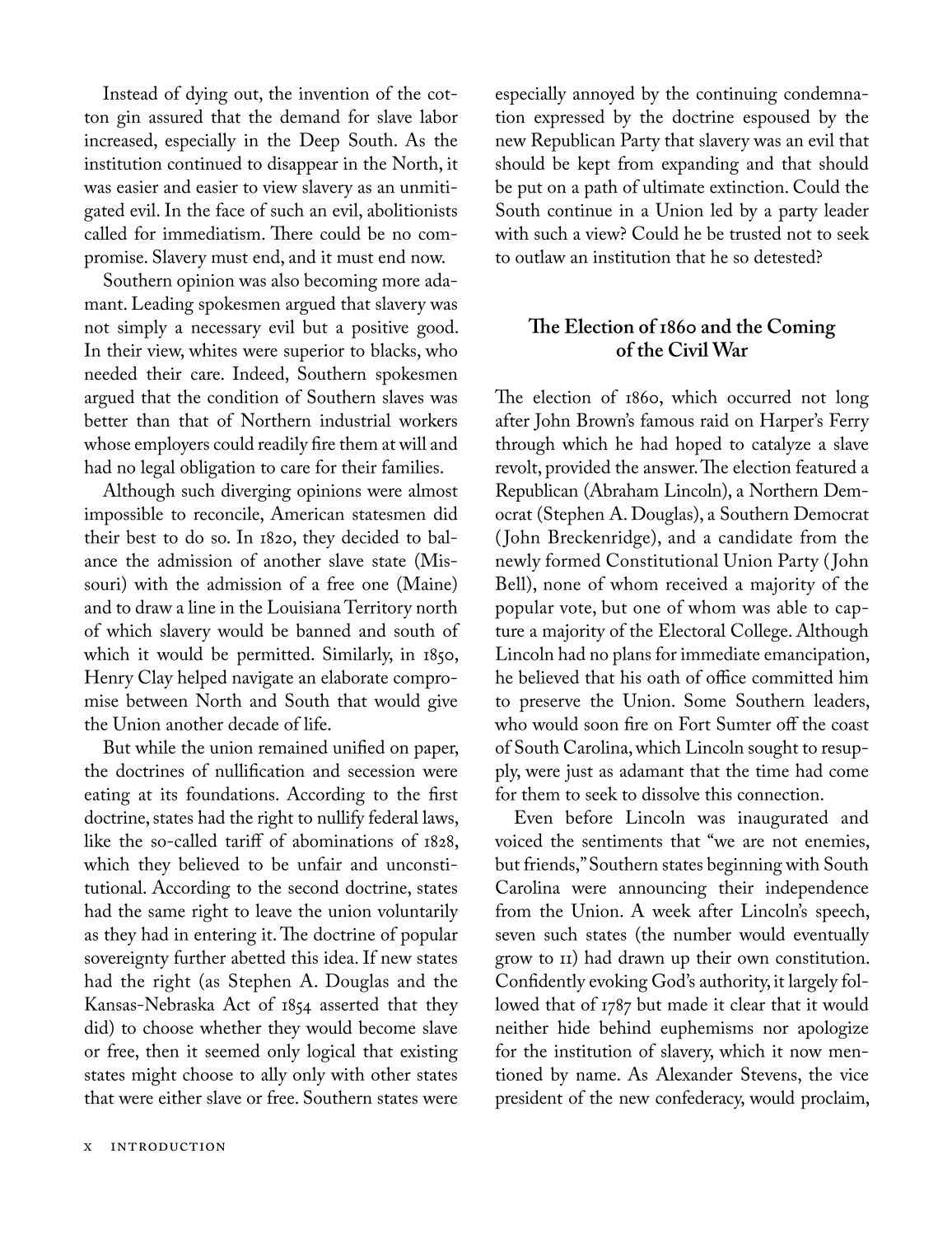x Introduction
Instead of dying out, the invention of the cot-
ton gin assured that the demand for slave labor
increased, especially in the Deep South. As the
institution continued to disappear in the North, it
was easier and easier to view slavery as an unmiti-
gated evil. In the face of such an evil, abolitionists
called for immediatism. Th ere could be no com-
promise. Slavery must end, and it must end now.
Southern opinion was also becoming more ada-
mant. Leading spokesmen argued that slavery was
not simply a necessary evil but a positive good.
In their view, whites were superior to blacks, who
needed their care. Indeed, Southern spokesmen
argued that the condition of Southern slaves was
better than that of Northern industrial workers
whose employers could readily fi re them at will and
had no legal obligation to care for their families.
Although such diverging opinions were almost
impossible to reconcile, American statesmen did
their best to do so. In 1820, they decided to bal-
ance the admission of another slave state (Mis-
souri) with the admission of a free one (Maine)
and to draw a line in the Louisiana Territory north
of which slavery would be banned and south of
which it would be permitted. Similarly, in 1850,
Henry Clay helped navigate an elaborate compro-
mise between North and South that would give
the Union another decade of life.
But while the union remained unifi ed on paper,
the doctrines of nullifi cation and secession were
eating at its foundations. According to the fi rst
doctrine, states had the right to nullify federal laws,
like the so-called tariff of abominations of 1828,
which they believed to be unfair and unconsti-
tutional. According to the second doctrine, states
had the same right to leave the union voluntarily
as they had in entering it. Th e doctrine of popular
sovereignty further abetted this idea. If new states
had the right (as Stephen A. Douglas and the
Kansas-Nebraska Act of 1854 asserted that they
did) to choose whether they would become slave
or free, then it seemed only logical that existing
states might choose to ally only with other states
that were either slave or free. Southern states were
especially annoyed by the continuing condemna-
tion expressed by the doctrine espoused by the
new Republican Party that slavery was an evil that
should be kept from expanding and that should
be put on a path of ultimate extinction. Could the
South continue in a Union led by a party leader
with such a view? Could he be trusted not to seek
to outlaw an institution that he so detested?
Th e Election of 1860 and the Coming
of the Civil War
Th e election of 1860, which occurred not long
after John Brown’s famous raid on Harper’s Ferry
through which he had hoped to catalyze a slave
revolt, provided the answer. Th e election featured a
Republican (Abraham Lincoln), a Northern Dem-
ocrat (Stephen A. Douglas), a Southern Democrat
(John Breckenridge), and a candidate from the
newly formed Constitutional Union Party (John
Bell), none of whom received a majority of the
popular vote, but one of whom was able to cap-
ture a majority of the Electoral College. Although
Lincoln had no plans for immediate emancipation,
he believed that his oath of offi ce committed him
to preserve the Union. Some Southern leaders,
who would soon fi re on Fort Sumter off the coast
of South Carolina, which Lincoln sought to resup-
ply, were just as adamant that the time had come
for them to seek to dissolve this connection.
Even before Lincoln was inaugurated and
voiced the sentiments that “we are not enemies,
but friends,” Southern states beginning with South
Carolina were announcing their independence
from the Union. A week after Lincoln’s speech,
seven such states (the number would eventually
grow to 11) had drawn up their own constitution.
Confi dently evoking God’s authority, it largely fol-
lowed that of 1787 but made it clear that it would
neither hide behind euphemisms nor apologize
for the institution of slavery, which it now men-
tioned by name. As Alexander Stevens, the vice
president of the new confederacy, would proclaim,
























































































































































































































































































































